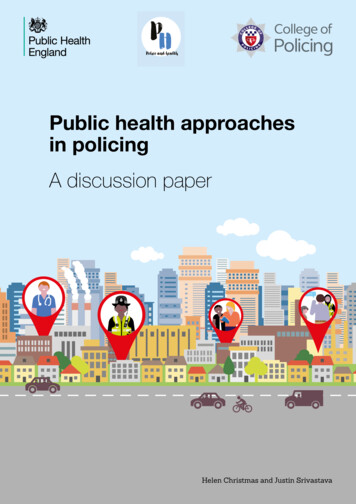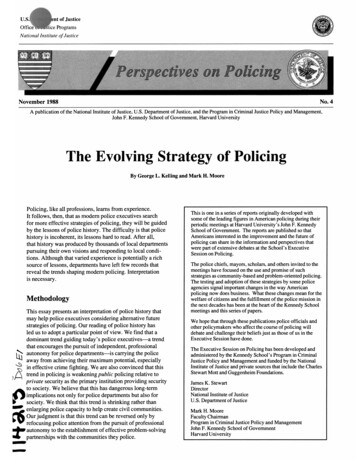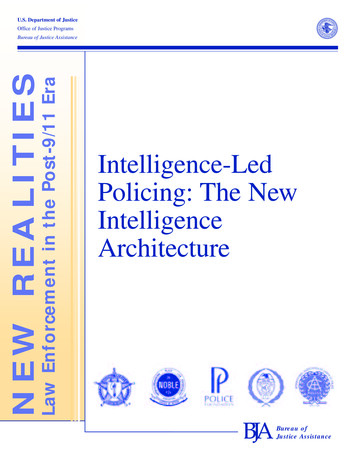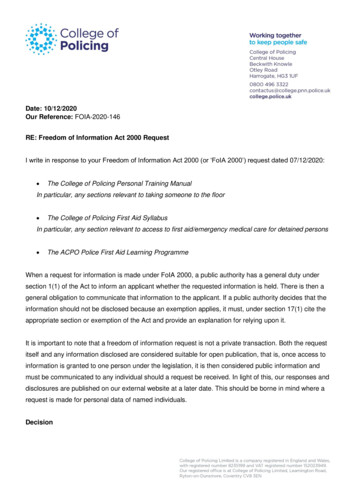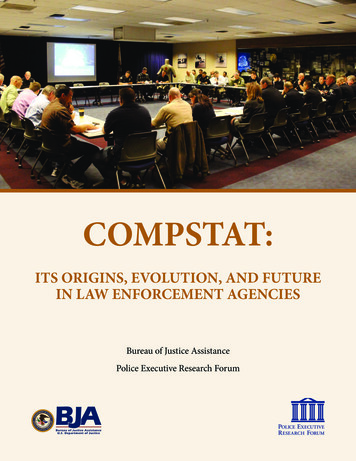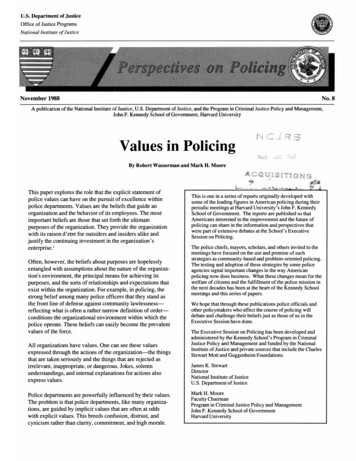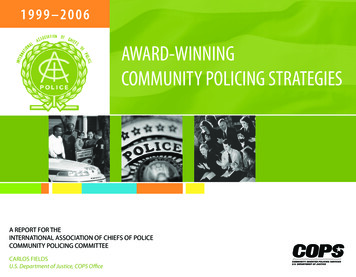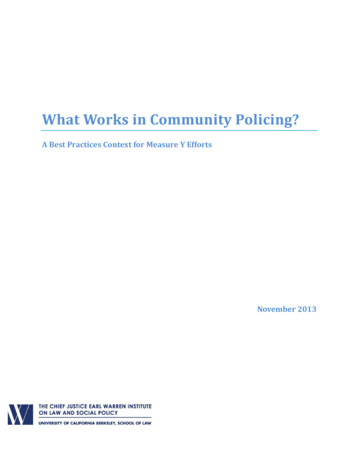
Transcription
What Works in Community Policing?A Best Practices Context for Measure Y EffortsNovember 2013
The Chief Justice Earl Warren Institute on Law and Social PolicyUniversity of California, Berkeley School of LawThe Chief Justice Earl Warren Institute on Law & Social Policy at the UC Berkeley School of Law is aresearch and policy center with the mission of bridging the gap between academia and practice. As part ofBerkeley Law, the Warren Institute leverages the intellectual capital of a world-class public university toproduce high-quality data, action-oriented research, and evidence-based policy recommendations on many ofsociety's most challenging issues.Resource Development AssociatesResource Development Associates is a mission driven consulting firm founded in 1984 to promote thewelfare of our communities by contributing to the effective functioning of public and non-profit health andhuman service systems. To this end, we provide a suite of consulting services to community-based nonprofits and local, state and federal agencies. Please take the time to visit our web pages to learn more aboutus and the important services that we offer. www.resourcedevelopment.netBright Research GroupBright Research Group helps public, private and non-profit agencies measure the difference they are making,maximize their ability to offer quality services, align their work to best practices and develop long-termstrategies to transform systems and communities.Authored by Sarah Lawrence and Bobby McCarthy of the Warren Institute
ContentsIntroduction . 4What is Community Policing? . 5What are the Key Components of Community Policing? . 5Organizational Transformation . 6Community Partnership . 7Problem Solving . 9Keys to Successful Community Policing. 12Common Challenges and Barriers to Success . 12Community Policing and Measure Y . 12In Alignment with Best Practices . 13Not in Alignment with Best Practices . 13Oakland Police Department: A Department in Flux . 14Measure Y as an Opportunity . 15References . 16
IntroductionIn November 2004 Oakland voters passed the Violence Prevention and Public Safety Act, commonly referredto as Measure Y.1 The stated, overarching goal of Measure Y is to improve public safety, with a particularfocus on reducing violence involving Oakland youth. Revenues from the 10-year parcel tax support threecomponents: violence prevention programs, community policing officers, and fire and paramedic services.In addition, up to 3% of funding is set aside for an independent evaluation. This report, which is part of thatevaluation effort, looks at “community policing” from a national perspective in terms of the generally agreedupon goals, principles, components, and strategies in the field of policing. It summarizes what we knowabout community policing from a few decades of learning, research, and implementation efforts. It thenexamines the community policing components of Measure Y and the extent to which they are aligned withthese best practices. In short, how do the community policing elements, as articulated in the 2004resolution, generally measure up to what we know are the most effective components of communitypolicing?The 10-year period for Measure Y sunsets in 2014 and City leaders and Oakland voters will need to decidethe future of this public safety investment. This report aims to help provide a national context for thosediscussions and deliberations that is grounded in research and best practices. The goal is to provide variousstakeholders a framework for strengthening community policing efforts in Oakland. Intended audiencesinclude the Mayor, City Council members, Oakland Police Department (OPD) leadership, members of theViolence Prevention and Public Safety Oversight Committee, City residents, and community-basedorganizations, among others.This assessment is based on a review of the social science research literature, including the seminal articlesthat are generally considered to be the foundations for what we know about community policing and thelatest studies that have built upon that foundation. In addition, it draws from publications by keyorganizations in the field of policing such as the U.S. Department of Justice, Community Oriented PolicingServices (COPS) Office, U.S. DOJ, Bureau of Justice Assistance, and the Police Executive Research Forum(PERF).It is worth noting that the City of Oakland is undergoing significant changes and reforms on several fronts,some of which are supported by external monitors and national experts including those related to theNegotiated Settlement Agreement and recommendations being put forward from the Bratton Group andStrategic Policy Partnership. Those efforts are relatively more prescriptive in nature. The purpose of thisreview is to provide a framework of the “bigger picture” principles and components of community policing inlight of the fact that leaders and residents will be revisiting this significant public safety investment in theupcoming year.1Oakland City Council (2004). Resolution No. 78734 C.M.S., Revised 7-20-04.
What is Community Policing?For the first half of the 20th century, police departments in most jurisdictions in the United States operatedunder what is generally referred to as a “professional” model of policing. Under this model, local policedepartments were organized around strict hierarchical lines, utilized standardized operational protocols, andemphasized responding to serious crimes when they occurred. As social disorder and crime rates began torise during the second half of the century, law enforcement and other municipal leaders began to re-examinethe role of police departments in public safety management and craft reform efforts that sought to reducecrime through improved relationships and direct partnerships between citizens and police.These efforts eventually coalesced around a new philosophy of law enforcement known as “communitypolicing,” which stressed more direct officer involvement with local citizens, was organized around less rigidhierarchies and protocols, and attempted to address the root causes of neighborhood crime with theassistance of the larger community.2 Adoption of the community policing philosophy by local policedepartments occurred gradually throughout the 1970’s and 1980’s and by the early 1990’s, more and morecities were beginning to adopt community policing approaches.3 After decades of adoption at the local level,community policing was effectively endorsed by the federal government with the passage of the ViolentCrime Control and Law Enforcement Act of 1994. This bill authorized an initial six-year expenditure of 8.8billion in federal aid to support community policing efforts, and created the Office of Community OrientedPolicing Services (COPS) to distribute and monitor this funding. Today, the COPS Office continues tooperate community policing initiatives nationwide and distribute grant funds to localities to support thoseefforts.4Increased funding and recognition of community policing success stories led to an explosion of itsimplementation in the following years. In 1994, only 20% of surveyed police departments nationallyreported employing some elements of the community policing model, a figure which rose to 58% in asubsequent 1997 survey, and 68% by 2003.5 Community policing remains the dominant local lawenforcement philosophy in the United States today, with 81% of the nation’s population being served by lawenforcement agencies that have adopted community policing approaches.6 However, as will be discussedbelow, while community policing is generally considered the “new norm” in local law enforcement,departments’ structures and practices still vary considerably across jurisdictions and community policing stillmeans different things to different people.What are the Key Components of Community Policing?In general terms, community policing is not a program; it is not a set of activities; it is not a personneldesignation. Rather, community policing is a law enforcement philosophy, a way of thinking about improvingpublic safety. While there is a lack of standardization regarding specific terminology and strategies ofcommunity policing across cities, community policing efforts can generally be grouped into three broad2Diamond & Weiss (2009). Advancing Community Policing Through Community Governance: A Framework Document. US Department ofJustice.3Bureau of Justice Assistance (1994). Understanding Community Policing: A Framework for Action. US Department of Justice.4Community Oriented Policing Services (2013). COPS History: 1994 to the Present. U.S. Department of Justice.5Connell et. al. (2008). ”Can a Community Policing Initiative Reduce Serious Crime? A Local Evaluation.” Police QuarterlyVol. 11.6Community Oriented Policing Services (2012). COPS FY 2013 Performance Budget.
categories: organizational transformation, community partnership, and problem solving. Each of thesecomponents is described in some detail below. By definition, a comprehensive community policing modelpermeates almost every aspect of a police department and the elements described below are best applied to apolice department as a whole.Key Components of Community Policing Organizational Transformation Community Partnership Problem SolvingOrganizational TransformationThe first component of successful community policing initiatives involves transformational changes in theorganizational structure and operation of a police department. This transformation can involve managementpolicies, organizational structure, personnel practices, and information technology systems, among otheraspects of how a department is structured and operates.7Arguably, the cornerstone of organizational transformation is that police departments are organized aroundgeographically-based assignments and allocations. One of the main arguments behind this approach is thatgeographically-based assignments facilitate closer and more frequent contact between the officers who arededicated to those areas and the people who live and work in them. The thinking is that with increasedcontact comes increased understanding of the priorities and concerns of a neighborhood and betterknowledge around local resources and assets that could be leveraged to address those concerns.Another hallmark of community policing, that is related to but distinct from geographically-basedassignments, is decentralization. In this context, the decentralization of a police department means areduction in a reliance on top-down policy directives from department leadership, devolution in decisionmaking, and a reporting structure that is less hierarchical. Decentralization gives local officers and precinctleaders more authority and discretion and it enables them to find creative solutions to specific, individualneighborhood problems without the restrictions of blanket, overly-rigid policies. As part of their communitypolicing efforts cities across the country have instituted regional district models, with precinct leaders ofdifferent ranks exercising discretion and authority on the best ways to address their unique crime issues.8,9Police officers are given increased autonomy to craft creative strategies to address the specific concerns oflocal residents.7Diamond and Weiss (2009).Ibid.9Maguire and Wells (2009). Implementing Community Policing: Lessons From 12 Agencies. Community-Oriented Policing Services, USDepartment of Justice.8
To be effective, organizational transformation must occur at all levels of a police department and permeate avariety of systems and practices. For example, performance evaluation systems may be designed to evaluateofficers based on their community policing efforts; the recruitment and hiring of new officers can favorindividuals who have a “service orientation” to policing; and training that emphasizes community policing canbecome part of standard, in-service training.In this era of limited budgets in which police departments are expected to do more with less, jurisdictionsacross the country are increasingly using civilian employees as a source for human resources, as they aregenerally relatively inexpensive compared to sworn officers. Indeed, civilians comprise as much as 30% to50% of the staff of many departments.10 In this process, commonly referred to as “civilianization,” non-swornpersonnel are used to handle support roles such as administration, dispatch, crime scene forensics, recordkeeping, and other administrative duties.11 The infusion of civilian workers to handle these tasks has enabledmany departments to free up sworn personnel to focus on direct law enforcement duties and communitypolicing efforts. Indeed federal legislation, such as the Violent Crime Control and Law Enforcement Act andcommunity policing grants through the COPS’ program Making Officer Redeployment Effective, hasspecifically required agencies to hire and use civilian employees so that officers can be re-deployed tocommunity policing efforts.12 Although cost-savings are the most common motivation, a 2008 nationalreview of civilianization in U.S. police departments found that among 76 surveyed agencies, 59% cited“support of community policing efforts” as a motivation to hire more civilian workers.13Example from the Field: Staffing ConstraintsTo deal with sworn-personnel shortfalls, some cities have expanded the civilianization ofpolice services to include limited officer-level functions. For example, the City of SanFrancisco, faced with a slew of retiring officers for whom there was little funding toreplace, began in 2010 a program to train 16 “civilian investigators”. These paid, nonsworn employees are trained to respond to service calls dealing with non-violent crimessuch as car burglaries. They are tasked with performing basic work such as taking victiminformation, collecting evidence, and creating a report which is then referred to officersat the stations for further investigation.14Community PartnershipCommunity partnerships are absolutely critical in order for community policing efforts to be effective. Themantra of community involvement permeates almost every aspect of a department. In police departmentsthat have demonstrated a strong commitment to the philosophy of community policing, police officers andcommunity partners jointly prioritize and tackle public safety issues that are most important to thecommunity. Successful partnerships are more than just frequent contact or simply sharing information. Theyinvolve on-going efforts to work together in meaningful ways to address problems facing a neighborhood.10Maguire and Wells (2009).Forst, B. (2000). The Privatization and Civilianization of Policing: Boundary Changes in Criminal Justice Organizations.12Kostelac, Constance Anne (2008). The Changing Face of Police Organizations:Trends in Civilianization.13Ibid.14Police Executive Research Forum (2010). Is the Economic Downturn Fundamentally Changing HowWe Police?11
The commitment and buy-in to community partnerships happens at all levels, from command staff tosupervisors to line officers.In addition to individual residents, the term “community partners” encompasses a range of groups such asneighborhood associations, faith-based organizations, tenant councils, business groups, local governmentagencies, social service providers, schools (including elementary and secondary public and private schools,community colleges, vocational schools, and universities), and local businesses. These entities typically enjoya number of qualities that facilitate effective partnerships, including well-developed organizational structures,physical meeting spaces, social, political, and commercial networks, material and human resources,experienced leaders, and existing community participation. This makes them natural vehicles through whichthe police can engage with local constituents to address neighborhood concerns.Improving the accessibility of police and community services can also be an effective catalyst for communityengagement and a way to facilitate community partnership. One example of improved accessibility isincreasing the number of locations in which police services are provided or co-locating them with other civicservices. Successful cities have also utilized information technology to improve citizen communication andmake public safety information more timely and accessible. In a 2009 COPS survey of 12 agenciesimplementing community policing, nearly all of the evaluated agencies had department websites thatprovided information about crime alerts and included email addresses of individual officers so that citizenscould provide tips, give feedback, and communicate concerns.15Example from the Field: Police AccessibilityIn the City of Naperville, IL, police had been dealing with an emerging gang andburglary problem that was centered around a set of high density, multi-family housingcomplexes. The Naperville Police Department in 2002 opened a neighborhoodservice center in the area with extended evening hours and a mix of sworn andcivilian personnel. The center provided a number of basic civic and public safetyservices such as obtaining crime prevention information, filing police reports, payingutility bills, and obtaining parking permits. The center proved extremely popular,with hundreds of local residents utilizing a variety of services within the first threemonths of its opening.16In order for community partnerships to be effective, some degree of trust and mutual respect between thepolice and the community is necessary, and in cities across the country that trust and respect are oftenlacking. Many cities have experienced long histories of high crime, racial profiling, and police misconduct,factors that contribute to low levels of citizen trust in law enforcement. Rebuilding this trust is a critical precursor to the establishment of effective and authentic partnerships between communities and police.1516Maguire and Wells (2009).Ibid.
Problem SolvingPerhaps the most transformative aspect of the community policing movement has been the shift from thereactive crime-response model to a more proactive problem-solving or “problem-oriented policing” (POP)model.17 This approach puts a heavy focus on efforts to prevent crime before it happens by systematicallyidentifying and addressing specific social issues associated with criminal activity. Problem-oriented policingtends to encourage creative problem solving among officers, analysts, and community members to identifythe root causes of a problem and then figure out how best to address them. A 2010 review of the researchliterature found that as a whole, problem-oriented policing approaches had a statistically significant impact onimproving public safety.18Example from the Field: Community Partnership and Problem SolvingJoint task forces made up of the police and one or more existing community groupswere established to solve specific community problems. In the mid 1990’s, theAnaheim Police Department successfully reduced blight and disorder in theLeatrice/Wakefield neighborhood by working with landlords, tenants, and the Officeof Neighborhood Services to create a Neighborhood Advisory Committee tasked withremoving problem tenants and reducing unit overcrowding. In the following years,the neighborhood saw marked improvements in building safety, vacancy rates, andreductions in incident reports.19Police departments that are grounded in a community policing philosophy train and assign officers to dutiesthat are focused on creative and active problem solving and prevention, rather than simply reacting to crimeand disorder. In order for officers to do this effectively, some degree of autonomy is required, which is alsoan important aspect of organizational transformation described above. One of the most common approachesto problem solving in police departments is the SARA Problem-Solving Model. SARA stands for the fourstep process: Scanning, Analysis, Response, and Assessment. Evidence indicates that problem-orientedpolicing strategies based on the SARA method can achieve significant reductions in crime over traditionalresponse models. A 2010 summary of the ten most rigorous studies on the effectiveness of SARA-basedproblem-oriented policing between 1993 and 2006 concluded that these efforts achieved statisticallysignificant reductions in crime and disorder in their affected cities.2017Goldstein, H (1987). “Toward Community-Oriented Policing: Potential, Basic Requirements, and Threshold Questions.” Crimeand Delinquency Vol. 33 No. 6.18Weisburd et al. (2010). “Is Problem-Oriented Policing Effective in Reducing Crime and Disorder? Findings From a CampbellSystematic Review.” Criminology & Public PolicyVol. 9 Issue 1. The American Society of Criminology.19City Policy Associates (2000). Safer Neighborhoods Through Community Policing, Volume II: Three Case Studies. US Conference ofMayors.20Ibid.
The SARA ModelThe specifics of the implementation of the SARA method vary by jurisdiction and situation, but typicallyindividual beat officers or pairs of officers, in partnership with the community, are given the authority andresponsibility to identify the crime and disorder issues that are most prominent in their beats, prioritizethem, and develop solutions.21 Some POP efforts can be as simple as an individual officer asking a storeowner to improve the lighting of their storefront, while others can be more complex, longer-term issuessuch as zoning changes to improve a blighted neighborhood.22Some of the more effective POP approaches have occurred in police departments in which a formal set ofclearly-articulated, standardized procedures are in place. A shared understanding and clear guidance aboutthe necessary steps of a POP approach increase the likelihood that each of the critical steps in the process istaken in crafting and implementing effective responses to identified problems.2122Ibid.Diamond and Weiss (2009).
Example from the Field: SARA ApplicationA trial program conducted by the Jacksonville Sherriff’s Office (JSO) in 2010 assignedproblem-oriented policing officers working under a SARA-style problem-solvingframework to 22 of the city’s most violent criminal “hot spots” for a 90 day period, andcompared crime rates with those of the other 61 hot spots not subject to the program.Officers in the study group were directed to find creative, preventative ways to addresscrimes in their areas based on the unique needs and characteristics of their neighborhoods.Examples of the specific POP actions taken by members of the JSO included repairingdamaged fences, installing or improving street lighting, meeting with business and homeowners to improve security measures, graffiti removal, and park cleaning. At the end ofthe study period, problem-oriented policing was associated with a 33% drop in the rate ofstreet violence compared to traditional policing. 23Effective POP approaches are grounded in high-quality information and, therefore, high-quality informationtechnology systems are essential. One of the better-known POP approaches is the CompStat process, whichwas developed in New York City in the mid 1990’s and has since been adopted by many other major citiesthroughout the United States. Under CompStat, police department personnel are held accountable for crimelevels in their geographic areas and required to regularly present on the current conditions within their areas,as well as the strategies underway or in development to address those conditions. CompStat has been cited asa useful tool in enhancing community policing efforts by assisting officers in really understanding the natureof crime within their areas, enabling them to shape appropriate responses.24Example from the Field: SARA Method and TrainingNew officers in the Colorado Springs Police Department are required to undergo aformal, SARA-based training program developed by the Police Executive ResearchForum that includes completing a portfolio evaluation of their beat neighborhood priorto beginning active duty. The Reno, NV Police Department devotes specific courses inits academy to the instruction of the SARA model and its application to problemoriented policing.2523Taylor, Koper, and Woods (2011). “A Randomized Control Trial of Different Policing Strategies at Hot Spots of Violent Crime.”Journal of Experimental Criminology, Vol 7, Issue 2.24Maguire and Wells (2009).25Diamond and Weiss (2009).
Keys to Successful Community PolicingAs OPD continues to implement significant reform efforts and as the City revisits the renewal of Measure Y,it would be helpful to keep in mind what decades of experience from numerous police departments acrossthe country has taught us about successful community policing. The following issues have been found to assistpolice departments engage in effective community policing efforts: Form community partnerships with a wide-range of partners, above and beyond active residentgroups Increase the department’s accessibility to the residents it serves Train personnel at every level of the department in best practices in community policing Work towards increasing officer buy-in about the benefits of the community policing philosophy Prioritize sustained and meaningful commitment by the department’s leadership to thecommunity policing philosophy Integrate community policing activities into performance evaluation systems Continue to support systematic and standardized problem solving approachesCommon Challenges and Barriers to SuccessCommon challenges and barriers to the successful adoption of community policing can be summed up by thefollowing: It is hard work! The institutionalization of community policing through organizationaltransformation necessitates sufficient resources and sustained commitment from department executive staffand city leaders. Changing the culture of a department can be as difficult, if not more difficult, than changingpolicies, procedures, and training. Establishing and maintaining meaningful community partnerships requirean education of all stakeholders, the inclusion of missing voices, and a shared responsibility for the outcomes.Engaging in effective problem solving requires input from several information sources, high-quality andreliable data, officer autonomy to craft and implement targeted and creative solutions, and on-goingcommunication. None of this is easy.Community Policing and Measure YThe purpose of this report is provide what is known about the best practices in community policing ascontext as the City of Oakland reassesses this investment in public safety strategies. The challenge here is toapply community policing principles that are typically viewed from a department-wide perspective to anindividual resolution that directly impacts only a fraction of OPD’s police officers and policies. That said, it ispossible to examine the extent to which the community policing elements of Measure Y support acommunity policing philosophy. This assessment is based on a review of the 2004 Measure Y resolutionlanguage, previous reports published as part of the Measure Y evaluation effort, previous assessments byexpert consultants, meeting minutes from Violence Prevention and Public Safety Oversight Committee meetings,
and selected media coverage.26 Some aspects of Measure Y’s community policing elements are well-alignedwith the principles and best practices outlined above. However, other aspects of Measure Y’s communitypolicing elements could be better aligned to best practices.The core of Measure Y’s community policing effort is the provision of funding for 63 officers assigned tovarious community policing objectives. The resolution establishes Neighborhood Beat Officers in which“each community policing beat shall have at least one neighborhood officer assigned solely to serve theresidents of that beat to provide consistent contact and familiarity with the residents and officers, continuityin problem solving, and basic availability of police response in each neighborhood.” These officers workclosely with Neighborhood Crime Prevention Councils (NCPCs), responding to the concerns ofneighborhood residents in their beats by attending local meetings and working on issues that are identified aspriorities by each NCPC. Oakland residents are currently served by 57 NCPCs that historically havecorresponded geographically to OPD police beats. At least six of the 63 officers are designated as CrimeReduction Team (CRT) officers who are tasked to “investigate and respond to illegal narcotic transactions andcommission of violent crimes in identified violence hot spots.” 27 Additional community policing objectives asarticulated in the resolution in
upon goals, principles, components, and strategies in the field of policing. It summarizes what we know about community policing from a few decades of learning, research, and implementation efforts. It then examines the community policing components of Measure Y and the extent to which they are aligned with these best practices.
